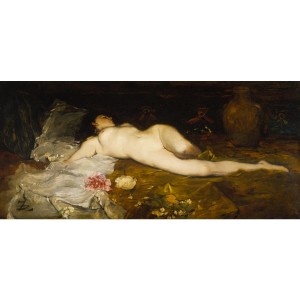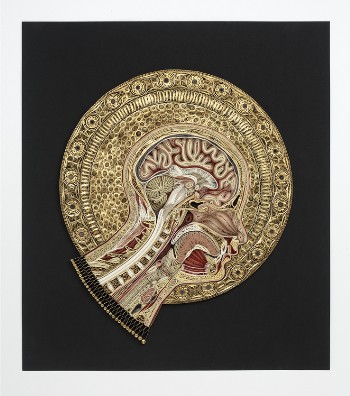Visual Arts: A Splendid “Teaching the Body” — Exploring the Venerable Art of Anatomy
Anyone interested in figurative art ought to rush over to Boston University’s Stone Gallery before Teaching the Body ends this Sunday.
Teaching the Body: Artistic Anatomy in the American Academy from Copley, Rimmer, and Eakins to Contemporary Artists. At the Stone Gallery at the Boston University Art Gallery, Boston, MA, through March 31. Exhibition is free and open to the public.
By Franklin Einspruch

Frank Duveneck, Reclining Nude, circa 1890, oil on canvas, loaned from the Terra Foundation for American Art, Chicago, Daniel J. Terra Collection
At one time in Massachusetts, drawing was not just a pleasant, cultivated pastime—it was the law. In 1870, the state passed the Massachusetts Drawing Act, which mandated that every public school in the Commonwealth was to teach drawing. Fully titled “An Act Relating to Free Instruction of Drawing,” it also declared that any town with a population over 10,000 people was to offer drafting instruction to citizens over the age of 15.
Prior to this, as pointed out by Naomi Slipp, a PhD candidate in American Art at Boston University and curator of Teaching the Body: Artistic Anatomy in the American Academy, figure drawing instruction was hard to come by. This obliged interested parties to attend medical courses, setting a particular kind of instruction into motion that has had an effect on art all the way to the present.
Scientific understanding of human anatomy and the development of orthogonal perspective were the principal achievements of the Renaissance. It’s not too much to say that because of them, Western art looks the way it does from the fifteenth to the twentieth centuries. As Leonardo da Vinci put it,
It is indispensable to a painter who would be thoroughly familiar with the limbs in all the positions and actions of which they are capable, in the nude, to know the anatomy of the sinews, bones, muscles and tendons so that, in their various movements and exertions, he may know which nerve or muscle is the cause of each movement and show those only as prominent and thickened, and not the others all over, as many do who, to seem great draughtsmen, draw their nude figures looking like wood, devoid of grace; so that you would think you were looking at a sack of walnuts rather than the human form, or a bundle of radishes rather than the muscles of figures.
Thus a lack of available instruction on human anatomy posed a serious hurdle for an artist. Although Dr. John Warren, whose dissection classes in the late 1700s eventually led to the establishment of the Harvard Medical School, ended up being the first source of this knowledge locally, it was William Rimmer’s combined talents as a physician and an artist that put the situation right. Teaching the Body has plates from his book on the topic, which is still available, as well as a striking, prodigious, stone sculpture of a male nude carved when the artist was 15.
Slipp notes that artistic anatomy had become a staple of the art school curriculum by 1875, including requirements that students produce anatomically knowledgeable figure drawings in order to advance through programs at the Massachusetts Normal School (now MassArt) and the School of the Museum of Fine Arts, Boston. She surveys this period in the late nineteenth century though the display of a wealth of objects, including an 1880 drawing by May Lillian Smith of a skeleton visualized from the posterior view into an antique cast and a stunning watercolor by Gustavo Simoni from 1878 of a standing, male nude. There is also a luscious, reclining, female nude (ca. 1890) by Frank Duveneck in oil that typifies what facility one can wield once given anatomical knowledge. Slipp also provides some photographs of classrooms from the time, such as a gathering of women at the Massachusetts Normal School from 1875. They are standing around a skull, presenting themselves as proud heirs of the Western tradition.
Contemporary art makes an appearance in Teaching the Body as well, affirming that this tradition continues. Notable among these works are Self-Portrait Sagittal Slice (1994) by Edward Stitt, who teaches at BU, rendering his thoughtful visage á la Velazquez but with a vertical section of his head removed, and an astonishing construction by western Massachusetts artist Lisa Nilsson of a cross-section of a head in profile surrounded by a gilded halo, rendered in paper filigree.
Slipp, whose full title at BU is the Jan and Warren Adelson Fellow in American Art, did enormous justice to this subject despite the limited means at her disposal, with her obvious expenditures of elbow grease including a successful Kickstarter campaign. Anyone interested in figurative art ought to rush over to the Stone Gallery before Teaching the Body ends this Sunday. If you find your appetite for figure drawing thus whetted, know that it continues all over the area, with continuing education programs at the colleges, drop-in open drawing sessions at places like The Eliot School, and even independent atelier instruction such as the Boston Figurative Art Center. It may no longer be the law, but it’s as gratifying a pursuit as it has ever been.
Franklin Einspruch is a Boston-based artist and writer. His website is einspruch.com; follow him on Twitter @franklin_e.
Tagged: Artistic Anatomy in the American Academy, Naomi Slipp, Stone Gallery

